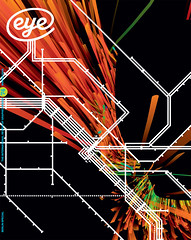Winter 2009
Running on empty
Ed Ruscha: Fifty Years of Painting
Hayward Gallery, London<br>14 October 2009 to 10 January 2010The work of artists such as Ed Ruscha, who base their art on language, raises some interesting issues for graphic designers. It has conventionally been seen as the designers’ role to reduce uncertainty and focus the message. Yet the essential tools of the trade – words and pictures – have the potential to go to far more ambiguous and disruptive places than the job usually allows. Ruscha studied graphic design and typography in the 1950s and he might easily have become a designer himself. Instead, emerging at the moment when Abstract Expressionism was about to yield to Pop, he hit on the idea of making the shape and content of words the subject of his pictures.
Ruscha’s retrospective at the Hayward Gallery surveys his entire career as a painter. In the words of gallery director Ralph Rugoff, Ruscha is a ‘semiotic Houdini’ who repeatedly breaks free from the chains of interpretation that critics try to bind around him. Ruscha is wonderfully laid back when asked what it all means. ‘I’m empty headed in many ways,’ he admits in the catalogue, ‘and don’t know why I follow what I follow...Logic flies out of the window when you’re making a picture.’
The words Ruscha paints can come from anywhere: it might be a phrase in a newspaper, or a sentence that popped into his head or appeared in a dream. In his early pictures, he uses single words – ‘Boss’, ‘Noise’, ‘Oof’, ‘Purity’, ‘Faith’ – and it wasn’t until the 1980s that longer phrases became the norm. At this point he also began to employ a typeface of his own design, with squared off curves, which he called Boy Scout Utility Modern. Words reverse-stencilled on the canvas, and usually centred, hover in the air like billboard copy-lines or Hollywood film titles. Sometimes the phrase relates to the background; often it doesn’t. The voice speaking in Honey... I Twisted Through More Damn Traffic to Get Here (1984) seems to be having a bad day, but the sky (or is it just blue paint?) behind the words is bright and hopeful.
It’s a curious typeface: artless and irregularly proportioned, it looks like something seen on the side of a crate, or used as wall signage in a factory. The letter-spacing is variable, the pencil guidelines often show, and the painted edges of the letters are less even than reproduction suggests. Ruscha has stuck with Boy Scout, declining to apply what he knows about type as a designer, because he doesn’t want the style of the lettering to reflect the meaning of the words. What meaning, then, should we attribute to position and spacing? In A Particular Kind of Heaven (1983), the words floating in the empyrean in a rare asymmetrical arrangement, above a deep blue bar that could be the sea, drift far away towards the edges of the picture. Are they just blissed out by the scene?
Ruscha’s paintings of the 1960s are gnomically cool. Some such as Standard Station (1966) and Los Angeles County Museum of Art on Fire (1968) are now iconic. More often, especially when seen in sequence at the Hayward, the early pictures give the impression of an artist trying things out, casting around for a direction without much of a programme. Whatever conceptual justification one applies to a picture of the word ‘Radio’ distended by clamps, or a drinking glass shattered by a marble, their visual appeal is limited. In the early 1970s, Ruscha stopped painting for a while.
Since the 1980s, his voice has been clearer, the emotional content of the pictures much more direct and affecting. His work is as strong as ever and the mountain series in the final room comprises some of his most memorable pictures. On images of sublime nature closer in treatment to picture postcards than to landscape painting, he inscribes banal phrases in Boy Scout Utility Modern about air travel, parking and American tools.
Ruscha’s subject has become the disquiet of change, of endings, of loss. There are frequent intimations of mortality. In a series of acrylics, dark, misty silhouettes representing the coming of the pioneers to America shudder with mute foreboding. Ruscha is openly suspicious of 21st-century technology: computers, cell phones, even TV – he titles a wordless picture of a TV set next to a big window, offering a glimpse of the world outside, Stupid Idiot. In Blue Collar Tech-Chem (1992), he paints a dour, box-like industrial building under a black sky. That might seem an alarming vision, but in 2003, the same structure, now upgraded and postmodernised, is serving as the headquarters of ‘Fat Boy’ – media company? fast-food enterprise? fashion brand? – below furious red apocalyptic clouds, as though the whole city is burning.
Always inspired by driving along the highway, Ruscha pictures a multi-panelled roadside sign stripped of every message, leaving only an empty white frame. The words will return later, purged of shoptalk, re-energised with ambiguity and reclaimed as art.
First published in Eye no. 74 vol. 19 2009
Eye is the world’s most beautiful and collectable graphic design journal, published quarterly for professional designers, students and anyone interested in critical, informed writing about graphic design and visual culture. It is available from all good design bookshops and online at the Eye shop, where you can buy subscriptions and single issues.

